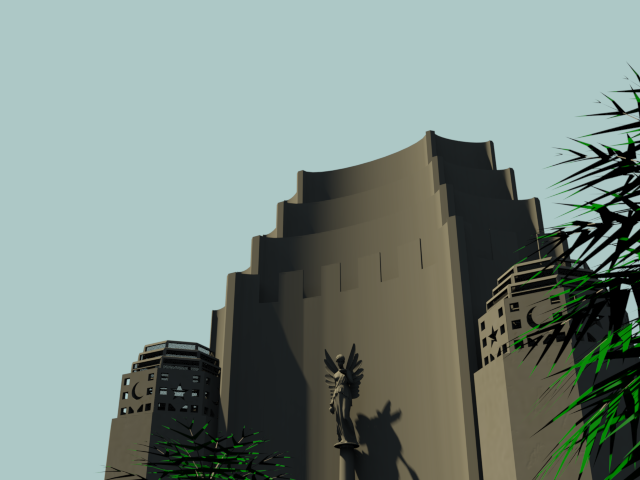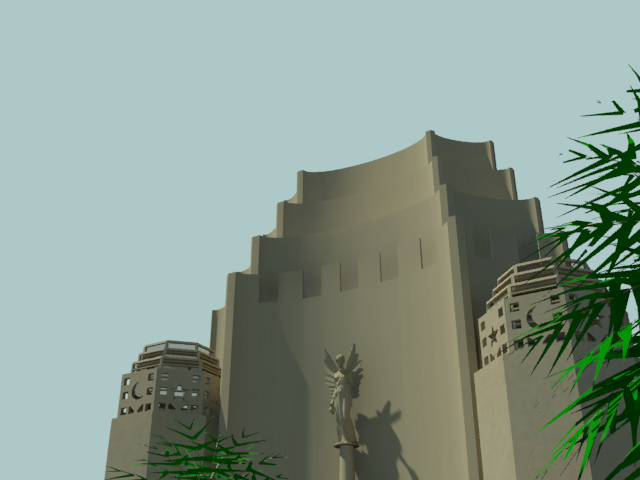The Quicksilver hardware renderer uses graphics hardware to generate renderings.
One advantage of the Quicksilver hardware renderer is its speed. The default settings provide rapid rendering.

Quicksilver rendering. Time: 4 seconds

mental ray rendering of the same scene, for comparison. Time: 24 seconds
The Quicksilver hardware renderer accelerates rendering by using both the CPU (Central Processing Unit) and the Graphics Processing Unit (GPU). It is somewhat like having a game-engine renderer within 3ds Max. The main role of the CPU is to translate scene data for rendering; this includes compiling shaders for the specific graphic card in use. Because of this, the first frame you render can take a while, as shaders are compiled. This needs to happen only once per shader: The more often you use the Quicksilver renderer, the faster it will become.
You can render multiple transparent surfaces.

Car rendered with a transparent body to show interior parts. Shadows show transparency as well.
You can render to the non-photorealistic styles also provided by Nitrous viewports.
Hardware Considerations
 Diagnose Video Hardware. This displays a dialog with details about your graphics configuration, including GPU Shader Model Support, which shows the Shader Model version number.
Diagnose Video Hardware. This displays a dialog with details about your graphics configuration, including GPU Shader Model Support, which shows the Shader Model version number. - The Quicksilver renderer uses only a single GPU at a time.
- The GPU should have at least 512 MB of graphics memory; we recommend 1 GB or more.
- The Quicksilver renderer does not use CUDA (Compute Unified Device Architecture) or OpenGL: It uses only DirectX.
Shadows in Quicksilver Hardware Renderings
The Quicksilver hardware renderer supports most of the shadow controls associated with light objects, but always generates shadow-mapped shadows. These shadows are adaptive, and adjust to the scale of the scene: They never show the jagged edges that can appear on scanline-rendered shadow-mapped shadows if you choose an inappropriate shadow map size.
For area lights, the Quicksilver renderer can generate soft-edged shadows.
The Quicksilver renderer doesn't support patterns in shadows (Shadow Parameters  Map).
Map).
Supported Materials
| Material Type | Restrictions |
|---|---|
| Arch & Design material | The Quicksilver renderer ignores these settings for the Arch & Design material:
|
| Autodesk Materials | The Quicksilver renderer ignores these settings for Autodesk Materials:
Note: The Quicksilver renderer does not support ProMaterials from 3ds Max 2010 scenes.
|
| Standard material | |
| Double-Sided material | |
| Multi/Sub-Object material |
Supported Maps and Shaders
| Map or Shader Type | Restrictions |
|---|---|
| MetaSL shaders | See Map to Material Conversion and DirectX Shader Material. |
| DirectX shaders | See DirectX Shader Material. |
| mr Physical Sky |
Note: If you turn on Use Custom Background Map, the background is visible in reflections and refractions, but does not otherwise contribute to the lighting of the scene.
|
| Utility Gamma & Gain shader | |
| Standard maps | When you use a Bitmap, make sure that Tiling is on (it is on by default). For the Falloff map, the main settings are supported but not Mix Curve or Output settings; however, the MetaSL Component Falloff shader is fully supported. The following Standard maps are not supported:
Reflections are always box projections: Planar projections are not supported. |
Additional Capabilities and Restrictions
| Feature | Capabilities and Restrictions |
|---|---|
| Render Elements | Supports these Alpha and Z Depth elements:
|
| Render to Texture | Not supported |
| Object Properties settings | The Quicksilver renderer ignores these, but the Renderable and Visibility properties are passed to the renderer by 3ds Max, so these settings work as expected. |
Using the Quicksilver Renderer: Tips and Tricks
- If an object appears black in a Quicksilver rendering, then either the material applied to the object is unsupported, or it is too complex to compile. Replace the material with one that the Quicksilver renderer can support (or try using a different renderer).
Performance Considerations
- Noise maps require a lot of computation and can slow performance or even cause the renderer to run out of memory.
- For bitmaps, if you don't care about the 2D coordinate settings for the standard Bitmap map, use the MetaSL Texture Lookup 2d shader instead: This is more efficient and lets you add more bitmaps to a material.
- The more objects with reflective surfaces, the more time the scene will take to render.